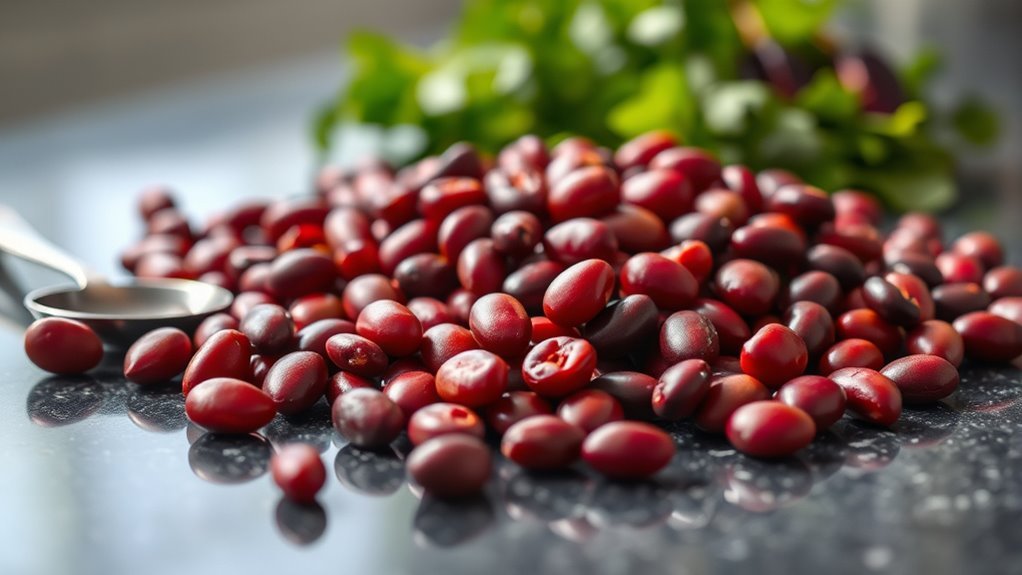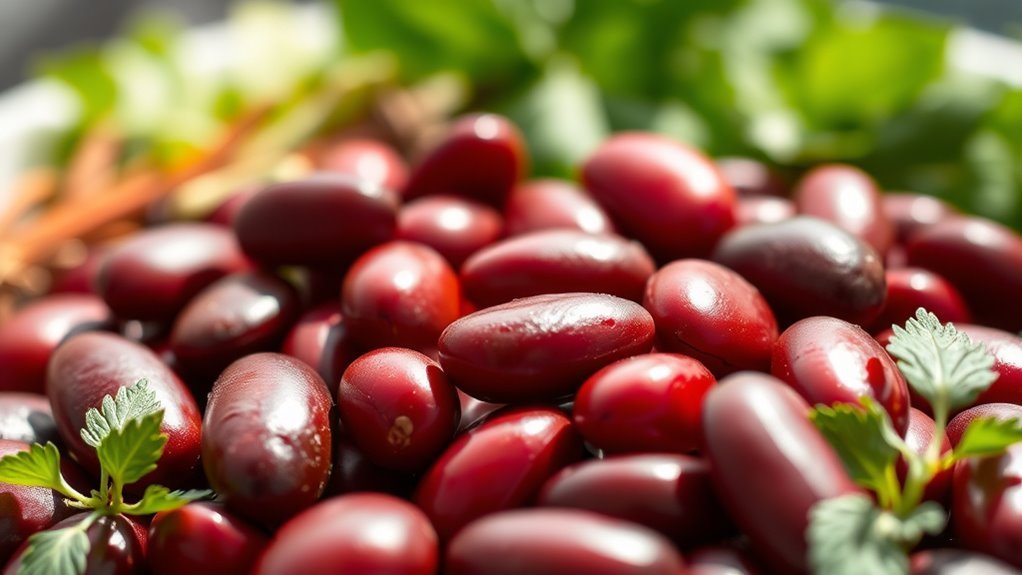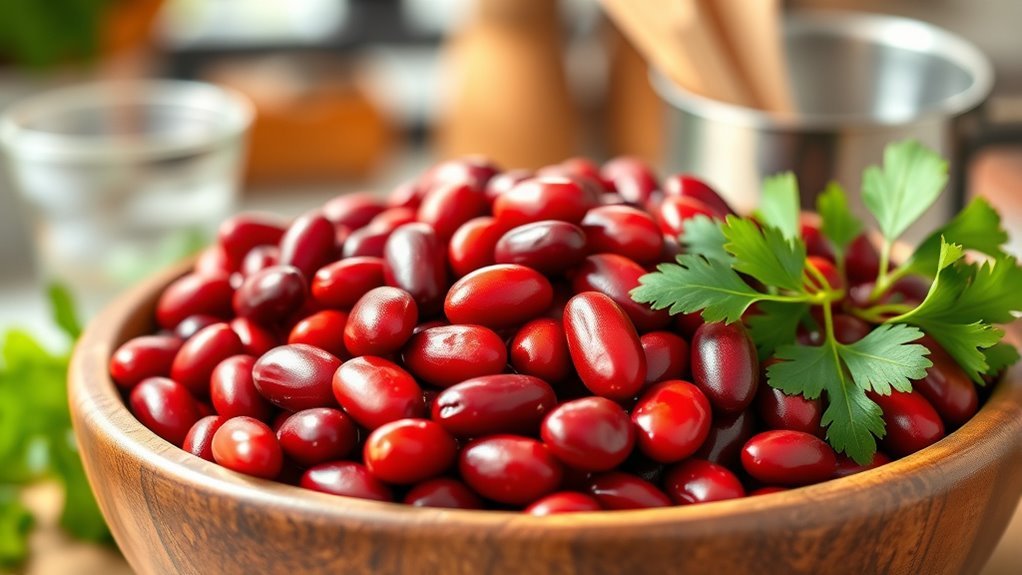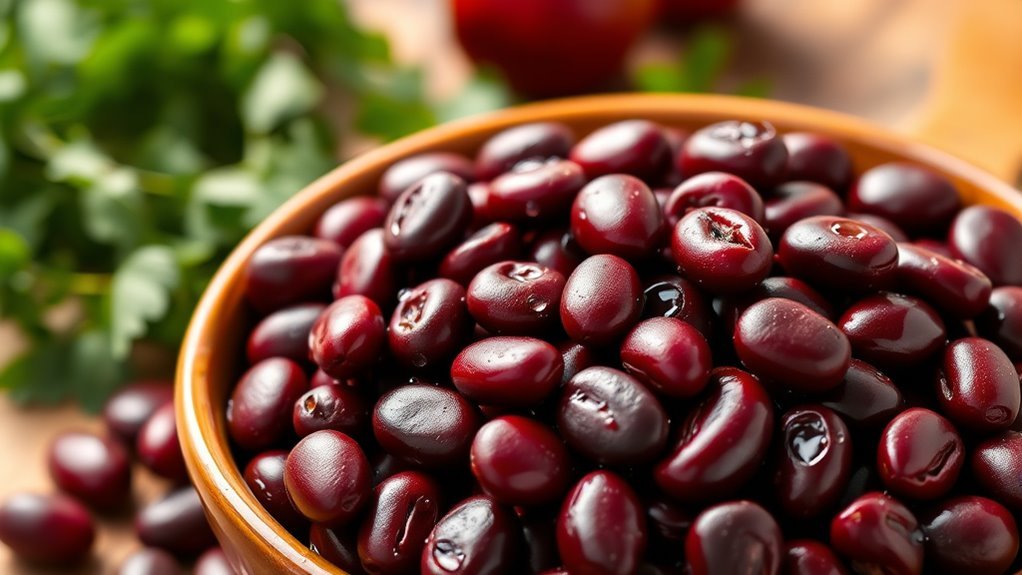Kidney beans aren’t typically regarded keto-friendly due to their higher carbohydrate content, which can hinder ketosis. One cooked cup contains about 22 grams of carbs, making it challenging to fit into strict low-carb limits. While they’re a great source of protein and fiber, you should be cautious with portion sizes. If you want to enjoy kidney beans while maintaining your keto goals, there are strategies to take into account. Discover how to incorporate them effectively into your meals.
Nutritional Profile of Kidney Beans

When considering the nutritional profile of kidney beans, it’s helpful to look at their macronutrient composition. These beans are packed with protein, offering about 15 grams per cooked cup, making them an excellent plant-based protein source. This protein content supports muscle growth and repair while helping you feel full longer, which can aid in weight management. Additionally, kidney beans are rich in dietary fiber, with around 13 grams per cup. The fiber benefits are significant; it promotes digestive health, stabilizes blood sugar levels, and can lower cholesterol. Incorporating kidney beans into your meals can provide you with these essential nutrients, contributing to a balanced diet that supports freedom of choice in your eating habits.
Carb Content and Its Impact on Ketosis

Although kidney beans offer numerous health benefits, their carbohydrate content can pose a challenge for those following a strict ketogenic diet. With about 20 grams of carbs per cup, these legumes can quickly exceed your daily carb restrictions. This could hinder your ability to maintain ketosis, the metabolic state where your body burns fat for fuel instead of glucose. When considering the ketosis effects, even small amounts of high-carb foods like kidney beans can disrupt your progress. If you’re committed to a keto lifestyle, it’s essential to monitor your carb intake closely. Ultimately, prioritizing low-carb veggies and proteins may be more aligned with your dietary goals, allowing you the freedom to enjoy the benefits of ketosis without compromising your progress.
Comparing Kidney Beans to Other Legumes

While kidney beans are rich in nutrients, they aren’t the only legumes on the market, and comparing them to other options can be enlightening for those on a keto diet. When you look at the nutritional comparison, you’ll find that other legume varieties, like black beans and lentils, also provide essential vitamins and minerals. However, they often come with higher carbohydrate content, which can impact your ketosis. For instance, black beans pack about 20 grams of carbs per cup, while kidney beans offer around 22 grams. If you’re prioritizing lower carb intake, consider options like edamame or green beans, which are lower in carbs and can fit better into a keto lifestyle. Choosing wisely among legumes can help you maintain your dietary goals.
Health Benefits of Kidney Beans
Kidney beans offer a variety of health benefits that can be advantageous for your overall well-being. Packed with fiber, they promote digestive health, keeping you full and satisfied. Their antioxidant properties help combat oxidative stress, potentially reducing the risk of chronic diseases. Kidney beans also support heart health by lowering cholesterol levels and maintaining blood pressure due to their rich content of soluble fiber and potassium. Additionally, they provide a good source of plant-based protein, making them a great option for those looking to enhance their diet. Incorporating kidney beans into your meals can contribute to a balanced, nutritious diet, allowing you the freedom to enjoy food while nourishing your body.
Incorporating Kidney Beans Into a Keto Diet
If you’re following a keto diet and wondering how to include kidney beans, it’s important to contemplate their carbohydrate content. While kidney beans are nutritious, they do contain more carbs than other low-carb options. To incorporate them wisely, consider using smaller portions in your meal planning. For instance, you might add a few kidney beans to a salad or a keto chili recipe, balancing them with high-fat ingredients to maintain your macro ratios. Explore keto recipes that utilize beans in moderation, like a bean-infused soup that complements your protein sources. By being mindful of portions and pairing them with healthy fats, you can enjoy kidney beans without derailing your keto goals, ensuring you stay on track while savoring diverse flavors.
Alternative Protein Sources for Keto Followers
As you explore alternative protein sources on a keto diet, you’ll find that there are plenty of options to keep your meals exciting and nutritious. While traditional meat sources are popular, incorporating plant-based proteins can be a game-changer. Foods like tofu, tempeh, and seitan provide substantial protein while maintaining low carb counts. You might also consider nuts and seeds, which not only add protein but healthy fats too. If you’re open to keto alternatives, look for high-quality protein powders derived from pea or hemp, which can be mixed into smoothies or baked goods. By diversifying your protein sources, you can enjoy a balanced diet while sticking to your keto goals, all while exploring new flavors and textures.


